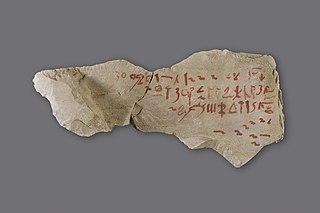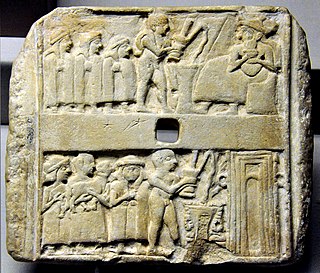The Book of Proverbs is a book in the third section of the Hebrew Bible traditionally ascribed to King Solomon and his students later appearing in the Christian Old Testament. When translated into Greek and Latin, the title took on different forms: in the Greek Septuagint (LXX) it became Παροιμίαι ; in the Latin Vulgate the title was Proverbia, from which the English name is derived.
The Old Testament (OT) is the first division of the Christian biblical canon, which is based primarily upon the 24 books of the Hebrew Bible, or Tanakh, a collection of ancient religious Hebrew and occasionally Aramaic writings by the Israelites. The second division of Christian Bibles is the New Testament, written in Koine Greek.

Hermes Trismegistus is a legendary Hellenistic period figure that originated as a syncretic combination of the Greek god Hermes and the Egyptian god Thoth. He is the purported author of the Hermetica, a widely diverse series of ancient and medieval pseudepigraphica that lay the basis of various philosophical systems known as Hermeticism.
Akkadian literature is the ancient literature written in the Akkadian language in Mesopotamia during the period spanning the Middle Bronze Age to the Iron Age.

Ziusudra of Shuruppak is listed in the WB-62 Sumerian King List recension as the last king of Sumer prior to the Great Flood. He is subsequently recorded as the hero of the Eridu Genesis and appears in the writings of Berossus as Xisuthros.

Hermeticism or Hermetism is a philosophical and religious system based on the purported teachings of Hermes Trismegistus. These teachings are contained in the various writings attributed to Hermes, which were produced over a period spanning many centuries and may be very different in content and scope.

The Book of Wisdom, or the Wisdom of Solomon, is a book written in Greek and most likely composed in Alexandria, Egypt. It is not part of the Hebrew Bible but is included in the Septuagint. Generally dated to the mid-first century BC, or to the reign of Caligula, the central theme of the work is "wisdom" itself, appearing under two principal aspects. The first aspect is, in its relation to mankind, wisdom is the perfection of knowledge of the righteous as a gift from God showing itself in action. The second aspect is, in direct relation to God, wisdom is with God from all eternity. It is one of the seven sapiential or wisdom books in the Septuagint, the others being Psalms, Proverbs, Ecclesiastes, Song of Songs, Job, and Sirach. It is one of the deuterocanonical books, i.e. it is included in the canons of the Catholic Church and the Eastern Orthodox Church, but most Protestants consider it part of the Apocrypha.

Atra-Hasis is an 18th-century BC Akkadian epic, recorded in various versions on clay tablets, named for its protagonist, Atrahasis. The Atra-Hasis tablets include both a cosmological creation myth and one of three surviving Babylonian flood myths. The name "Atra-Hasis" also appears, as a king of Shuruppak in the times before a flood, on one of the Sumerian King Lists.
Amenemope, the son of Kanakht, is the ostensible author of the Instruction of Amenemope, an Egyptian wisdom text written in the Ramesside Period. He is portrayed as a scribe and sage who lived in Egypt during the 20th Dynasty of the New Kingdom and resided in Akhmim, the capital of the ninth nome of Upper Egypt. His discourses are presented in the traditional form of instructions from father to son on how to live a good and moral life, but they are explicitly organized into 30 numbered chapters.

Ancient literature comprises religious and scientific documents, tales, poetry and plays, royal edicts and declarations, and other forms of writing that were recorded on a variety of media, including stone, clay tablets, papyri, palm leaves, and metal. Before the spread of writing, oral literature did not always survive well, but some texts and fragments have persisted. One can conclude that an unknown number of written works too have likely not survived the ravages of time and are therefore lost.

Instruction of Amenemope is a literary work composed in Ancient Egypt, most likely during the Ramesside Period ; it contains thirty chapters of advice for successful living, ostensibly written by the scribe Amenemope son of Kanakht as a legacy for his son. A characteristic product of the New Kingdom "Age of Personal Piety", the work reflects on the inner qualities, attitudes, and behaviors required for a happy life in the face of increasingly difficult social and economic circumstances. It is widely regarded as one of the masterpieces of ancient near-eastern wisdom literature and has been of particular interest to modern scholars because of its similarity to the later biblical Book of Proverbs.

Sumerian literature constitutes the earliest known corpus of recorded literature, including the religious writings and other traditional stories maintained by the Sumerian civilization and largely preserved by the later Akkadian and Babylonian empires. These records were written in the Sumerian language in the 18th and 17th centuries BC during the Middle Bronze Age.

The Instructions of Shuruppak are a significant example of Sumerian wisdom literature. Wisdom literature, intended to teach proper piety, inculcate virtue, and preserve community standards, was common throughout the ancient Near East. Its incipit sets the text in great antiquity by : "In those days, in those far remote times, in those nights, in those faraway nights, in those years, in those far remote years." The precepts are placed in the mouth of a king Šuruppak (SU.KUR.RUki), son of Ubara-Tutu. Ubara-Tutu is recorded in most extant copies of the Sumerian king list as being the final king of Sumer prior to the deluge. Ubara-tutu is briefly mentioned in tablet XI of the Epic of Gilgamesh, where he is identified as the father of Utnapishtim, a character who is instructed by the god Ea to build a boat in order to survive the coming flood. Grouped with the other cuneiform tablets from Abu Salabikh, the Instructions date to the early third millennium BCE, being among the oldest surviving literature.
The Book of Sirach, also known as The Wisdom of Jesus the Son of Sirach or Ecclesiasticus, is a Jewish work, originally written in Biblical Hebrew. The longest extant wisdom book from antiquity, it consists of ethical teachings, written approximately between 196 and 175 BCE by Yeshua ben Eleazar ben Sira, a Hellenistic Jewish scribe of the Second Temple period.

Sumerian religion was the religion practiced by the people of Sumer, the first literate civilization found in recorded history and based in ancient Mesopotamia. The Sumerians regarded their divinities as responsible for all matters pertaining to the natural and social orders.

The Song of the hoe or the Creation of the pickax is a Sumerian creation myth, written on clay tablets from the last century of the 3rd millennium BCE.
The personification of wisdom, typically as a righteous woman, is a motif found in religious and philosophical texts, most notably in the Book of Proverbs in the Hebrew Bible and other Jewish and Christian texts.

The Dialogue between a Man and His God is the earliest known text to address the answer to the question of why a god permits evil, or theodicy, a reflection on human suffering. It is a piece of Wisdom Literature extant on a single clay cuneiform tablet written in Akkadian and attributed to Kalbanum, on the last line, an individual otherwise unknown. It is dated to the latter part of the Old Babylonian period, around the reign of Ammi-Ditana according to Lambert, and is currently housed in the Louvre Museum, accession number AO 4462. It is of unknown provenance as it was purchased from an antiquities dealer by the Museum in 1906. It shares much of its style with an earlier Sumerian work, “Man and His God”, a penitential prayer of the Ur III period.
Counsels of Wisdom is a piece of Babylonian wisdom literature written in Akkadian containing moral exhortations. It is composed primarily of two-line units, without sections. A translation of extant portions of the text was published in Lambert 1996. Existing manuscripts are fragmentary, but the original was estimated to be about 160 lines.

Proverbs 7 is the seventh chapter of the Book of Proverbs in the Hebrew Bible or the Old Testament of the Christian Bible. The book is a compilation of several wisdom literature collections; the heading in 1:1 may be intended to regard Solomon as the traditional author of the whole book, but the dates of the individual collections are difficult to determine, and the book probably obtained its final shape in the post-exilic period. This chapter is a part of the first collection of the book.













